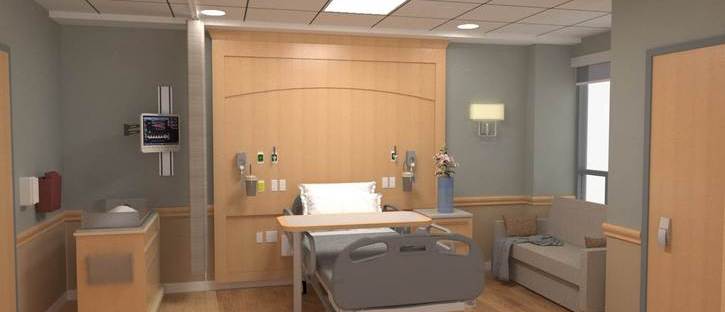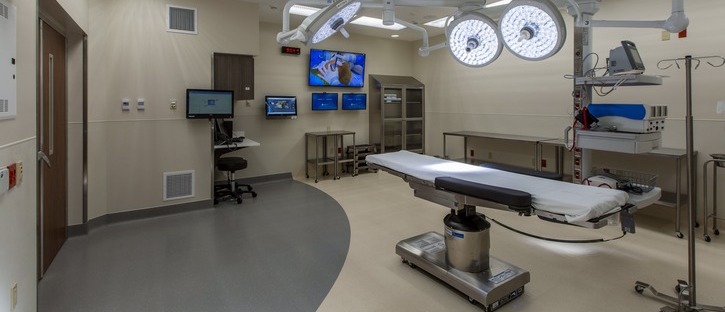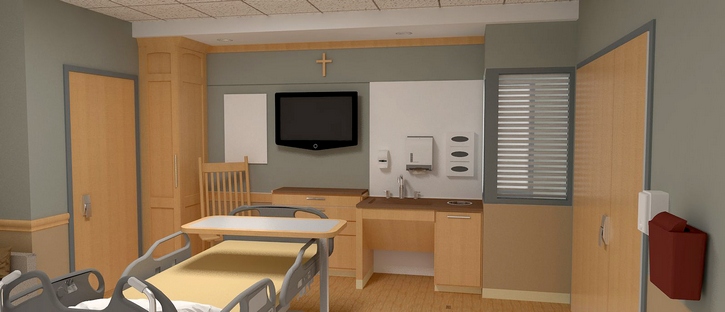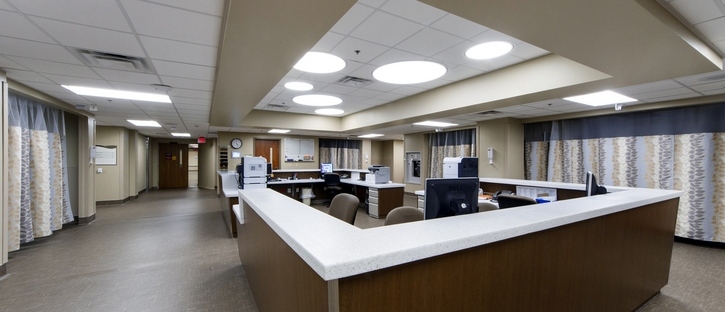 Standardized inpatient room, med-surg and postpartum headwall.
Standardized inpatient room, med-surg and postpartum headwall.  Saint Thomas Midtown Joint Replacement Center 600 SF operating room. Photo courtesy of Aerial Innovations of TN, Inc.
Saint Thomas Midtown Joint Replacement Center 600 SF operating room. Photo courtesy of Aerial Innovations of TN, Inc.  Standardized inpatient room, med-surg and postpartum footwall.
Standardized inpatient room, med-surg and postpartum footwall.  Saint Thomas Midtown combined prep-recovery shared between service lines. Photo courtesy of Aerial Innovations of TN, Inc.
Saint Thomas Midtown combined prep-recovery shared between service lines. Photo courtesy of Aerial Innovations of TN, Inc. Subscribe Now
Ahead of the Silver Wave: Facility Strategies for Baby Boomers
By Michelle Mader
Planning strategies for inpatient units, ORs to optimize investments and flexibility for changing utilization
The U.S. healthcare industry, which is already under economic pressure from payers, narrower healthcare networks and the healthcare law to provide value-based services at lower costs, is facing new challenges. The country is on the cusp of a significant bulge in the population bell curve, as the number of baby boomers over the age of 65 is growing by double digits year after year. With the growth of this population, healthcare will experience age-associated increases in acuity, demand and utilization in the short term.
These challenges will be compounded by the lack of access to primary care providers, which often results in a higher percentage of high-acuity cases with a higher average length of stay, contributing to increased facilities, equipment and staffing costs.
The Centers for Medicaid and Medicare Services is shifting higher-complexity surgical patients to the ambulatory environment and paying providers a flat rate for bundled services. Within the next 5-8 years, there is likely to see another wave of federal healthcare financial reform designed to support this shift in care from the inpatient environment to lower-cost ambulatory care settings.
Healthcare planners anticipate that the combined effects of healthcare reform, the dominance of the ambulatory care model and the natural decline of the baby boomer population over the next 15 years will take the industry down the curve again.
The optimal strategy to ride the curve is to invest the minimum required to meet predicted increases in demand and utilization, assure access and optimize flexibility in key departments and service lines for the next 3-5 years. This avoids the risk of excess long-term overhead, facility capacity and debt as the downward curve steepens.
The following are proven facility planning strategies for the high-investment areas of inpatient nursing units and in-hospital procedural areas, which are likely to be affected by the needs of the older boomer population over the next several years. These strategies are designed to enable organizations to avoid costs by building less, reduce costs by leveraging facilities and staff, and manage ongoing costs as utilization declines.
Bed Units: Standardized, Zoned, Micro-sized
Inpatient beds represent a significant investment in terms of infrastructure, space and associated capital, as well as ongoing operational costs. Consider that a typical inpatient bed requires, on average, 275-300 square feet of space at a total renovation capital cost of $400-600/square feet, as well as $45-55 per bed in ongoing operational costs (utilities, maintenance, etc.). It is essential to avoid building new bed capacity for the upward slope of the curve when it is likely to be underutilized in the future.
In most hospitals, beds tend to be segregated, classified and customized according to subspecialty. This reduces flexibility over time, increasing the potential for empty beds as utilization changes.
One way to optimize the capital investment in new beds is to standardize inpatient rooms across the entire medical/surgical platform — from general med/surg to orthopedics to neurology and even postpartum obstetrics — enabling staff to move seamlessly from one unit to another with no time lost in learning a new layout. The major elements of a standardized inpatient room are bed placement, headwall arrangement (specific location of gases, etc.), and locations of the hand-washing sink, medication cabinet and supply cabinet.
Another way to optimize the capital investment in beds is to place these units in the most appropriate setting, that is, to zone the hospital by vertical and horizontal adjacencies to provide the most flexibility in future years. That means dedicating the first floor to public, outpatient and back-of-house functions and avoiding the placement of high-density, high-investment inpatient units that are hard to convert to other uses in the future.
A third way to optimize the capital investment is through development of micro-units comprising 10-12 beds (on 1:5 or 1:6 nursing ratio), which can be designed to “turn on and off” as utilization fluctuates. This helps to keep operating overhead and staffing costs low.
All of these strategies are based on creating a flexible inpatient platform that optimizes infrastructure, operations and staffing over time — whatever changes may occur in the economy, demographics and healthcare reform.
ORs and Shared Prep/Recovery Spaces that Flex
At an average of 600 square feet and $500,000 in equipment alone, ORs represent one of the most significant in-hospital investments.
As higher-complexity surgical patients are increasingly shifted to ambulatory procedural centers, there is an opportunity to gain flexibility within existing hospital ORs that are designed smaller, less than 500 square feet. While existing OR qualifications enable them to be used increasingly for high-risk inpatients with co-morbidities, they also can be repurposed for other functions — in particular, for minimally clinical procedures, such as cardiac and vascular catheterization — when in-hospital surgical utilization declines.
A Comprehensive Approach
Although leveraging facilities is a key factor in avoiding, reducing and managing costs, a successful strategy for riding the curve is not based on a quantitative assessment of the facilities alone.
The optimal strategy is founded on comprehensive planning, in which a solution is developed based on both a quantitative and qualitative/spatial analysis — including staffing, patient satisfaction, flow, organizational and cultural factors — with a roadmap that clearly lays out the steps required to navigate from the current state to the future state.
The process starts with the primary consideration — what is best for the patient — and, second, what is best for the provider. Next, market needs are considered — demand, access, recruitment planning, patient prevalence and utilization rates by department or service line. Rounding out the process is an analysis of the implications on space and the logistics and phasing of construction. Ultimately, the planning team considers cost and ROI. The goal is to find the sweet spot among strategic and operational practices, facility alignment and affordability.
What is most often missed in the planning is accounting for the variability that occurs in healthcare every day — not in equipment, supplies and rooms, but in human behavior. For example, no one knew for certain, until passage of the healthcare law, the change in utilization patterns of states’ Medicaid solutions, which is changing hospital patient demographics. There is also the variability that comes from patients’ compliance with appointments, health management recommendations and medications, etc. In addition, there is considerable variability among providers’ skill sets, preferences, practice patterns and general timeliness.
A realistic flexible model plans and provides for contingencies — considering the standard deviation from the average — and builds contingency for the range from low to high within the constraints of affordability.
There is one more important consideration: culture and construction must be compatible. Strategies based on standardization, consolidation and economies of scale can only work if the hospital has organizational, cultural and operational flexibility to match the facilities.
For example, surgeons understand the benefits to the patient of interventional platforms, such as hybrid ORs and hybrid catheterization labs, in reducing complications, speeding recovery and improving outcomes. They also understand that their ability to perform a broader range of procedures will enable them to grow their practices.
However, at a minimum of 800 square feet, plus a control room and equipment room, a fully equipped hybrid OR requires an average initial investment between $3-5 million. If the culture is characterized by departmental silos, and the physicians prove to be unwilling to work together from the perspectives of scheduling, procedures, room design, supply and/or staffing, then utilization will be too low to cost-justify the investment.
Often the biggest challenge is getting buy-in to adopt the flexible design concept and change the operational model to reflect this concept. Yet, if the hospital cannot break down the silo culture — by guiding a culture change from a provider-focused culture to a patient-focused culture — then it is likely to continue building for areas already highly utilized, leaving the underutilized units alone. As a result, the campus becomes overbuilt with high overhead.
That’s one end of the spectrum.
On the other end of the spectrum are hospitals watching their inpatient days plummet across service lines and must consolidate and decommission space. They face the challenge of determining how to achieve greater efficiencies while considering the location of these spaces, staffing levels, care quality and patient satisfaction.
There is pain at both ends of this spectrum, but there are also surprising gains.
Leaders have discovered that the dialogue about these issues in and of itself can result in better understanding of each department’s and serviceline’s challenges and an opportunity to break down silos and work together for everyone’s benefit.
The next 15 years will prove to be increasingly challenging for a healthcare industry already pressured by the imperative to provide value-based services at lower costs. A comprehensive strategy — not only in areas that represent a high investment, but across the health system — will enable an organization to successfully avoid, reduce and manage costs as they ride the bell curve both upslope and down.
Author: Michelle Mader
Michelle Mader is director of strategy at FreemanWhite and helps healthcare system leaders envision the future. She works with the largest healthcare organizations across the country to align services with community needs and revenue growth. A frequent speaker at national conferences, Mader has published several articles on ambulatory strategies, population health and how capital investments can support these developing initiatives.
Tags: Facilities Management
Posted November 17, 2015
More Articles:
- Coverings 2024
Apr 22, 2024 – Apr 25, 2024 - Hospital, Outpatient Facilities & Medical Office Buildings Summit
Apr 25, 2024 – Apr 25, 2024 - CxA Workshop & Exam
Apr 29, 2024 – Apr 30, 2024 - EMP Seminar & Exam at CxEnergy 2024
Apr 29, 2024 – Apr 30, 2024 - CxEnergy
Apr 29, 2024 – May 2, 2024 - PHCC West 2024
Apr 29, 2024 – May 2, 2024 - Lean in Design Forum 2024
May 1, 2024 – May 2, 2024










